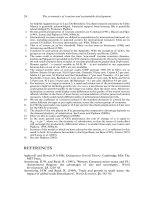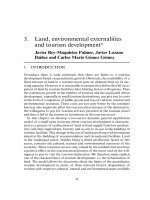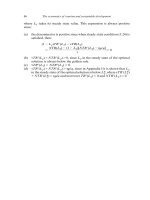THE ECONOMICS OF MONEY,BANKING, AND FINANCIAL MARKETS 153
Bạn đang xem bản rút gọn của tài liệu. Xem và tải ngay bản đầy đủ của tài liệu tại đây (90.61 KB, 1 trang )
The Risk and Term Structure of Interest Rates
121
Three-Month Bills (Short-Term)
Three-to-Five-Year Averages
FIGURE 6-4
2010
2008
2006
2004
2002
2000
1998
1996
1994
1992
1990
1988
1986
1984
1982
1980
1978
1976
1974
1972
1970
1968
1966
Long-Term Bond Average
1964
22
20
18
16
14
12
10
8
6
4
2
0
1962
Interest Rate (%)
CHAPTER 6
Movements over Time of Interest Rates on Government of Canada Bonds
with Different Maturities, 1962 2008
Source: Statistics Canada CANSIM II Series V122531, V122485, and V122487.
upward slope; when short-term interest rates are high, yield curves are more
likely to slope downward and be inverted.
3. Yield curves almost always slope upward, like the yield curves in the Financial
News box.
Four theories have been put forward to explain the term structure of interest
rates, that is, the relationship among interest rates on bonds of different maturities
reflected in yield-curve patterns: (1) the expectations theory, (2) the segmented
markets theory, (3) the liquidity premium theory, and (4) the preferred habitat theory. The expectations theory does a good job of explaining the first two facts on
our list but not the third. The segmented markets theory can explain fact 3 but not
the other two facts, which are well explained by the expectations theory. Because
each theory explains facts that the others cannot, a natural way to seek a better
understanding of the term structure is to combine features of all four theories,
which leads us to the liquidity premium and preferred habitat theories, which can
explain all three facts.
If the liquidity premium and preferred habitat theories do a better job of
explaining the facts and are hence the most widely accepted theories, why do we
spend time discussing the other two theories? There are two reasons. First, the
ideas in these two theories provide the groundwork for the liquidity premium and
preferred habitat theories. Second, it is important to see how economists modify
theories to improve them when they find that the predicted results are inconsistent with the empirical evidence.
Expectations
Theory
The expectations theory of the term structure states the following commonsense proposition: the interest rate on a long-term bond will equal an average
of short-term interest rates that people expect to occur over the life of the longterm bond. For example, if people expect that short-term interest rates will be
10% on average over the coming five years, the expectations theory predicts
that the interest rate on bonds with five years to maturity will be 10% too. If
short-term interest rates were expected to rise even higher after this five-year









